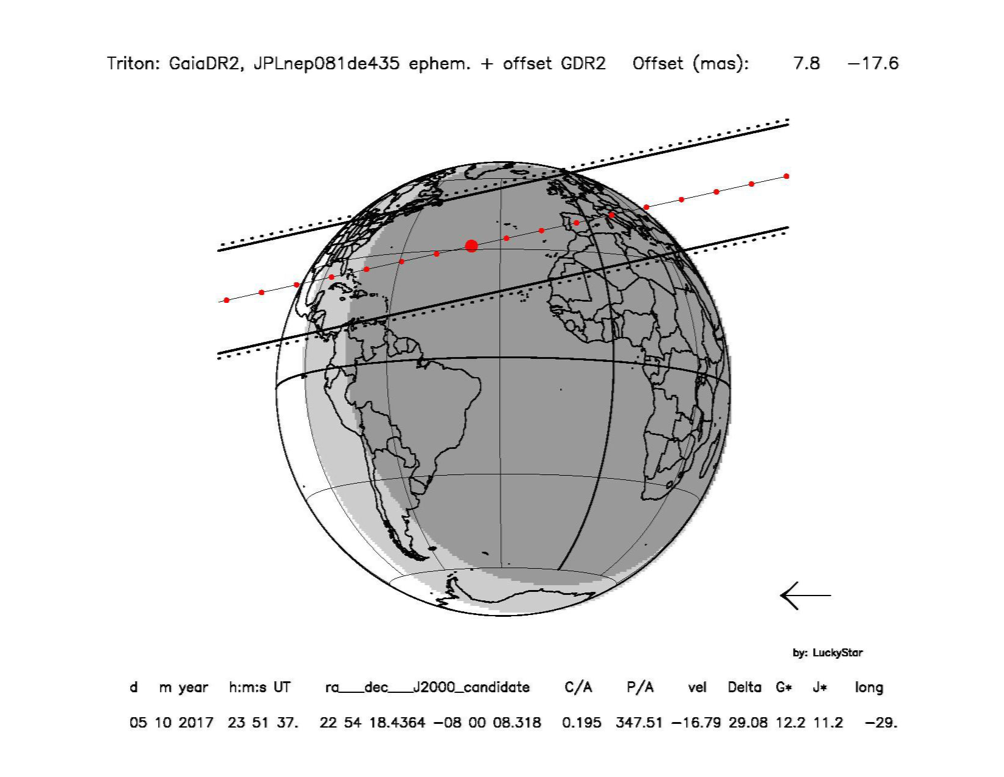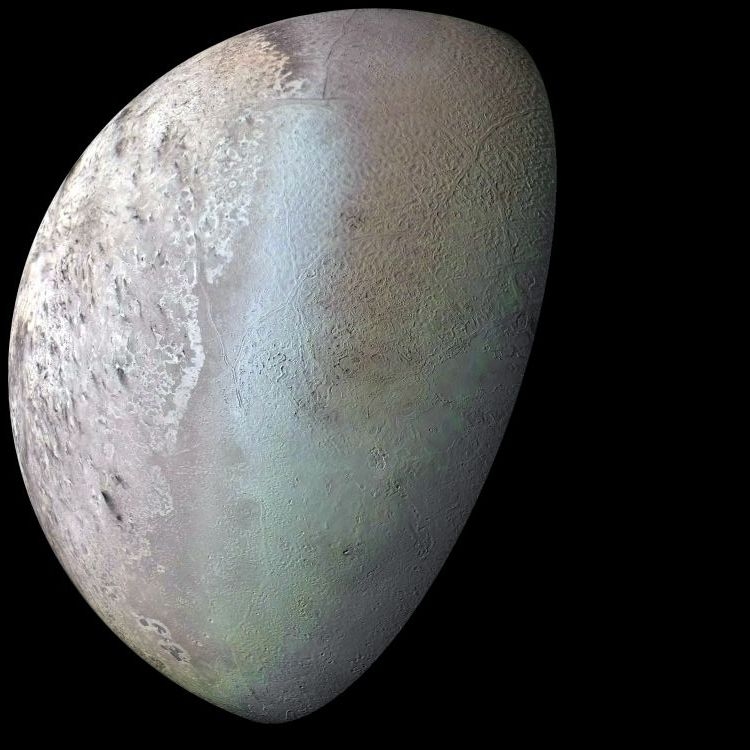The biggest moon of Neptune moon holds many surprises. First, Triton's orbit is retrograde: its rotation is in the opposite direction compared to that of its mother planet. There is also the presence of active mechanisms on its surface (geysers, possible plate tectonics) and the presence of a significant atmosphere filled with nitrogen, difficult to study at more than 4 billion kilometres from the Earth. "The study of Triton aims at deciphering its nitrogen cycle." Bruno Sicardy confirms, an astrophysicist at LESIA (Observatoire de Paris). A delicate balance despite the extreme temperatures: at -233 °C, the nitrogen ice sublimates into gas... Enough to stimulate daily and seasonal mechanisms that are found on Triton’s alleged cousin, Pluto. "Several similarities suggest that before being a satellite, Triton was a planet with identical characteristics, captured by Neptune when the solar system stabilised."
In 1989, The VOYAGER 2 probe flew over Triton and revealed it for the first time, but since then, astronomers use another method, indirect, to observe this moon: they take advantage of an alignment between the Earth, Triton and a star in the background. Although this passage only lasts a few minutes, the disturbance that the moon brings to the light spectrum of the star is then measured and studied. In 1997, thanks to HUBBLE, the stellar occultation allowed to see a warming of Triton’s atmosphere, but these alignments are extremely rare.
"Since 2002, more than 15 campaigns have been organised to observe the occultation of Pluto, but that of 2017 was the first real opportunity for Triton in 20 years!" B. Sicardy confirms. On 5 October 2017, the star "UCAC4 410-143659" passed behind Triton and to successfully observe this occultation, the objective was to coordinate the laboratories involved with a new precision. Because when the moon is perfectly centred with respect to the star in the background, its atmosphere creates a "flash".
"It works like a lens that gives us very precise information on the densest layers of its atmosphere, at 10 km from Triton's surface." Providing a real treasure in reward when several observatories can gather their data: "Its temperature density profile, the presence of winds and their power, but also the presence of mists and clouds by observing the flash in different wavelengths."
However, the stellar occultation of Triton is a very short event. Three minutes in all, only a few seconds of "flash". It is therefore necessary to predict the course of this event (such as a solar eclipse) with the lowest margin of error. To this end, Bruno Sicardy turned to the GAIA orbital telescope teams, which aims to map more than 1.3 billion nearby stars and their movements. A unique referencing, which was published in April 2018.
"GAIA's data is highly anticipated, for us it was crucial. And since Triton's observation is very rare, the teams have exceptionally given us access to the catalogue data in advance." Bruno Sicardy points out. The cooperation goes even beyond the position and movement of the star of the occultation: the GAIA team delivered the coordinates of more than 450 stars, which also allowed to track the exact position of Triton before 5 October. With a precision of the order of the millisecond of arc (the observation area of the "flash" on Earth is equivalent to 3ms of arc), the data from GAIA allowed to refine the teams’ position on Earth to observe the occultation of more than 300 km. "We have collected 80 observation reports, more than 25 of which contain flash data, which is exceptional."

Caption: Estimation of the trajectory of Triton’s occultation on 5 October 5 2017 refined thanks to the precise data of the Gaia telescope © Lucky Star Project, Bruno Sicardy
The campaign has also mobilised large telescopes of observatories (in the Canaries, Spain and Greece in particular) but more than two thirds of the data come from participatory research. Associations, clubs and astronomy enthusiasts have watched the event from Europe and the United States. "Thanks to these amateur participations, we can combine the data and obtain a vision of Triton's atmosphere on its entire surface. This is an inventory almost equivalent to that of Voyager 2 instruments!” Bruno Sicardy concludes, who was able to organise this observation campaign thanks to the support of the European Union for his "ERC Lucky Star" project.
TO GO FURTHER
On ESA's website : http://sci.esa.int/gaia/60011-chasing-a-stellar-flash-with-assistance-from-gaia/
Contacts
- Bruno Sicardy, astrophysicist at LESIA (Observatoire de Paris, CNRS, Sorbonne Université, Université Paris Diderot): bruno.sicardy at obspm.fr
- Olivier La Marle, programme manager of Astronomy and Astrophysics, CNES, olivier.lamarle at cnes.fr
 Triton captured by Voyager 2 in 1989. Credits : NASA/JPL/USGS
Triton captured by Voyager 2 in 1989. Credits : NASA/JPL/USGS